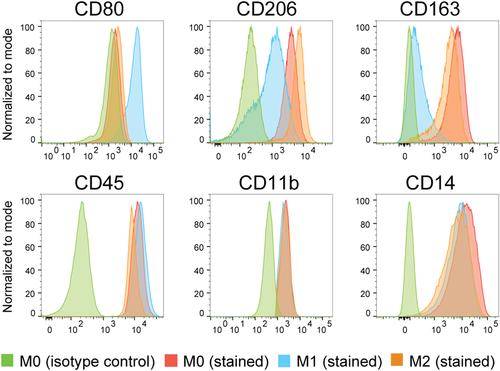下载PDF
{"title":"人诱导多能干细胞单核细胞和巨噬细胞的生成及功能表征","authors":"Xu Cao, Francijna E. van den Hil, Christine L. Mummery, Valeria V. Orlova","doi":"10.1002/cpsc.108","DOIUrl":null,"url":null,"abstract":"<p>Monocytes and macrophages are essential for immune defense and tissue hemostasis. They are also the underlying trigger of many diseases. The availability of robust and short protocols to induce monocytes and macrophages from human induced pluripotent stem cells (hiPSCs) will benefit many applications of immune cells in biomedical research. Here, we describe a protocol to derive and functionally characterize these cells. Large numbers of hiPSC-derived monocytes (hiPSC-mono) could be generated in just 15 days. These monocytes were fully functional after cryopreservation and could be polarized to M1 and M2 macrophage subtypes. hiPSC-derived macrophages (iPSDMs) showed high phagocytotic uptake of bacteria, apoptotic cells, and tumor cells. The protocol was effective across multiple hiPSC lines. In summary, we developed a robust protocol to generate hiPSC-mono and iPSDMs which showed phenotypic features of macrophages and functional maturity in different bioassays. © 2020 The Authors.</p><p><b>Basic Protocol 1</b>: Differentiation of hiPSCs toward monocytes</p><p><b>Support Protocol 1</b>: Isolation and cryopreservation of monocytes</p><p><b>Support Protocol 2</b>: Characterization of monocytes</p><p><b>Basic Protocol 2</b>: Differentiation of different subtypes of macrophages</p><p><b>Support Protocol 3</b>: Characterization of hiPSC-derived macrophages (iPSDMs)</p><p><b>Support Protocol 4</b>: Functional characterization of different subtypes of macrophages</p>","PeriodicalId":53703,"journal":{"name":"Current Protocols in Stem Cell Biology","volume":"52 1","pages":""},"PeriodicalIF":0.0000,"publicationDate":"2020-03-11","publicationTypes":"Journal Article","fieldsOfStudy":null,"isOpenAccess":false,"openAccessPdf":"https://sci-hub-pdf.com/10.1002/cpsc.108","citationCount":"18","resultStr":"{\"title\":\"Generation and Functional Characterization of Monocytes and Macrophages Derived from Human Induced Pluripotent Stem Cells\",\"authors\":\"Xu Cao, Francijna E. van den Hil, Christine L. Mummery, Valeria V. Orlova\",\"doi\":\"10.1002/cpsc.108\",\"DOIUrl\":null,\"url\":null,\"abstract\":\"<p>Monocytes and macrophages are essential for immune defense and tissue hemostasis. They are also the underlying trigger of many diseases. The availability of robust and short protocols to induce monocytes and macrophages from human induced pluripotent stem cells (hiPSCs) will benefit many applications of immune cells in biomedical research. Here, we describe a protocol to derive and functionally characterize these cells. Large numbers of hiPSC-derived monocytes (hiPSC-mono) could be generated in just 15 days. These monocytes were fully functional after cryopreservation and could be polarized to M1 and M2 macrophage subtypes. hiPSC-derived macrophages (iPSDMs) showed high phagocytotic uptake of bacteria, apoptotic cells, and tumor cells. The protocol was effective across multiple hiPSC lines. In summary, we developed a robust protocol to generate hiPSC-mono and iPSDMs which showed phenotypic features of macrophages and functional maturity in different bioassays. © 2020 The Authors.</p><p><b>Basic Protocol 1</b>: Differentiation of hiPSCs toward monocytes</p><p><b>Support Protocol 1</b>: Isolation and cryopreservation of monocytes</p><p><b>Support Protocol 2</b>: Characterization of monocytes</p><p><b>Basic Protocol 2</b>: Differentiation of different subtypes of macrophages</p><p><b>Support Protocol 3</b>: Characterization of hiPSC-derived macrophages (iPSDMs)</p><p><b>Support Protocol 4</b>: Functional characterization of different subtypes of macrophages</p>\",\"PeriodicalId\":53703,\"journal\":{\"name\":\"Current Protocols in Stem Cell Biology\",\"volume\":\"52 1\",\"pages\":\"\"},\"PeriodicalIF\":0.0000,\"publicationDate\":\"2020-03-11\",\"publicationTypes\":\"Journal Article\",\"fieldsOfStudy\":null,\"isOpenAccess\":false,\"openAccessPdf\":\"https://sci-hub-pdf.com/10.1002/cpsc.108\",\"citationCount\":\"18\",\"resultStr\":null,\"platform\":\"Semanticscholar\",\"paperid\":null,\"PeriodicalName\":\"Current Protocols in Stem Cell Biology\",\"FirstCategoryId\":\"1085\",\"ListUrlMain\":\"https://onlinelibrary.wiley.com/doi/10.1002/cpsc.108\",\"RegionNum\":0,\"RegionCategory\":null,\"ArticlePicture\":[],\"TitleCN\":null,\"AbstractTextCN\":null,\"PMCID\":null,\"EPubDate\":\"\",\"PubModel\":\"\",\"JCR\":\"Q2\",\"JCRName\":\"Biochemistry, Genetics and Molecular Biology\",\"Score\":null,\"Total\":0}","platform":"Semanticscholar","paperid":null,"PeriodicalName":"Current Protocols in Stem Cell Biology","FirstCategoryId":"1085","ListUrlMain":"https://onlinelibrary.wiley.com/doi/10.1002/cpsc.108","RegionNum":0,"RegionCategory":null,"ArticlePicture":[],"TitleCN":null,"AbstractTextCN":null,"PMCID":null,"EPubDate":"","PubModel":"","JCR":"Q2","JCRName":"Biochemistry, Genetics and Molecular Biology","Score":null,"Total":0}
引用次数: 18
引用
批量引用
Generation and Functional Characterization of Monocytes and Macrophages Derived from Human Induced Pluripotent Stem Cells
Monocytes and macrophages are essential for immune defense and tissue hemostasis. They are also the underlying trigger of many diseases. The availability of robust and short protocols to induce monocytes and macrophages from human induced pluripotent stem cells (hiPSCs) will benefit many applications of immune cells in biomedical research. Here, we describe a protocol to derive and functionally characterize these cells. Large numbers of hiPSC-derived monocytes (hiPSC-mono) could be generated in just 15 days. These monocytes were fully functional after cryopreservation and could be polarized to M1 and M2 macrophage subtypes. hiPSC-derived macrophages (iPSDMs) showed high phagocytotic uptake of bacteria, apoptotic cells, and tumor cells. The protocol was effective across multiple hiPSC lines. In summary, we developed a robust protocol to generate hiPSC-mono and iPSDMs which showed phenotypic features of macrophages and functional maturity in different bioassays. © 2020 The Authors.
Basic Protocol 1 : Differentiation of hiPSCs toward monocytes
Support Protocol 1 : Isolation and cryopreservation of monocytes
Support Protocol 2 : Characterization of monocytes
Basic Protocol 2 : Differentiation of different subtypes of macrophages
Support Protocol 3 : Characterization of hiPSC-derived macrophages (iPSDMs)
Support Protocol 4 : Functional characterization of different subtypes of macrophages



